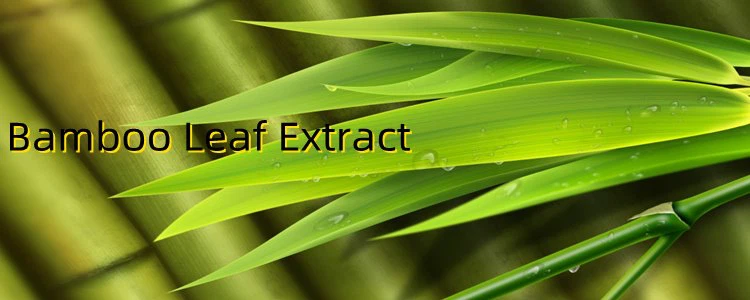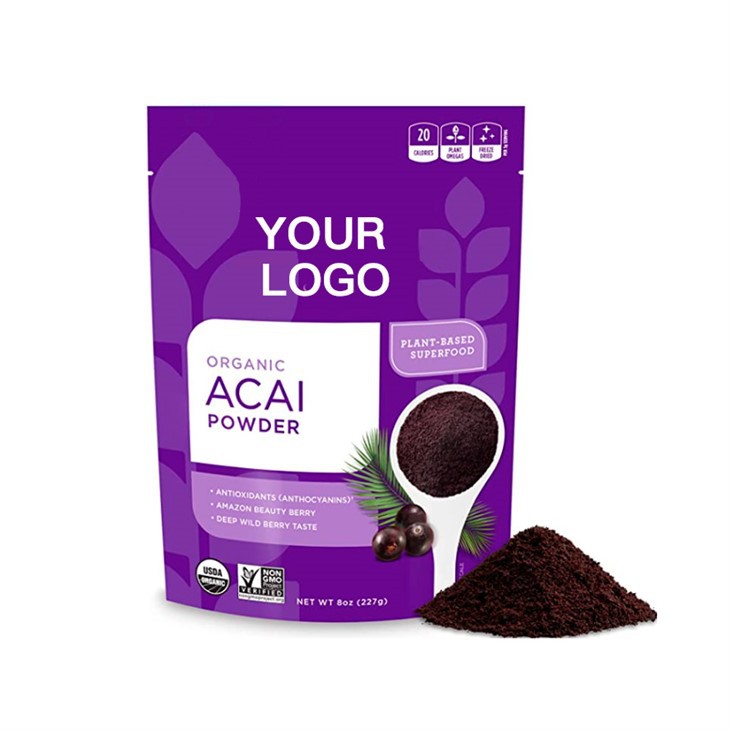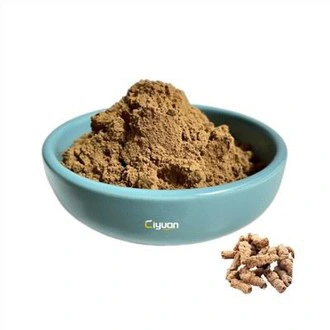What is Bamboo Leaf Extract?

Bambusa Vulgaris Bamboo Extract is the extract from the leaves of the evergreen trees or shrubs of Gramineae. The main active ingredient is bamboo leaf flavone, which has many biological activities such as antibacterial and insecticidal activities. It has a very broad application prospect in food preservation and pest control.
Bamboo leaf flavone is a natural organic mixture. It is mainly composed of Orientin, Homoorintin, Vitexin, and Isovitexin. It has great polarity and hydrophilicity and is easily soluble in hot water, methanol, ethanol, acetone, and other solvents. It has a phenol hydroxyl group and glycoside chain in its molecule and has a strong ability to generate hydrogen bonds, which is conducive to weak polarity and polar resin adsorption. It can be purified with macroporous resin and other organic macromolecular polymer adsorbent.
Bamboo leaf flavone is a kind of plant flavonoid preparation newly developed in the 1990s, which is made from wild bamboo leaves in high mountains. Its functional factor is flavonoid glycosides, and the main one is carbon glycoside flavone. The so-called flavonoid glycosides refer to the compounds formed by linking sugar groups at some positions of the flavonoid woody core. They are divided into two kinds: carbon glycoside flavones and oxygen glycoside flavones. The so-called carbon glycoside flavones refer to the sugar groups in the flavonoid woody core that are connected with the flavonoid mother nucleus through the - C - bond. Compared with oxy glycoside flavone, carbo glycoside flavone has the following outstanding advantages:
1. Stable structure, not easy to be degraded;
2. It can go deep into the focus and directly exert the curative effect;
3. Enhanced hydrophilicity is conducive to the development of drugs, food, cosmetics, etc.

Quality Control COA

ITEM | STANDARD | TEST RESULT | TEST METHOD |
Flavone | ≥10.0% | 10.28% | UV |
Physical & Chemical | |||
Appearance | Brown Fine Powder | Complies | Visual |
Odor & Taste | Characteristic | Characteristic | Organoleptic |
Particle Size | 95% pass 60 mesh | Complies | USP<786> |
Loss on drying | ≤6.0% | 2.59% | USP<731> |
Ash | ≤5.0% | 2.17% | USP<281> |
Solubility | Easy dissolved in warm water, No peacoke | Complies | Visual |
Heavy Metal | |||
Pb | ≤3.0ppm | Complies | ICP-MS |
As | ≤2.0ppm | Complies | ICP-MS |
Microbiological Test | |||
Total Plate Count | ≤1,000cfu/g | 309cfu/g | AOAC |
Mold & Yeast | ≤100cfu/g | 45cfu/g | AOAC |
E.Coli | Negative | Negative | AOAC |
Conclusion: Conform with specification |
Function

1. Protect cardiocerebral vessels
Bamboo Extract has the effect of lowering blood lipids, inhibiting platelet aggregation and thrombosis, and can play a health function of assisting in protecting the cardiovascular and cerebrovascular. Abnormal increase of blood lipid is one of the risk factors for cardiovascular and cerebrovascular diseases. Reducing the high level of low-density lipoprotein cholesterol, total cholesterol, and triglycerides in serum and increasing the level of high-density lipoprotein cholesterol are conducive to preventing cardiovascular and cerebrovascular diseases. Bamboo leaf flavone extract can significantly reduce the concentrations of triglyceride, total cholesterol, and LDL cholesterol in the blood of SD rats. The middle and high dose groups can significantly increase the HDLC cholesterol concentration, and its effect on reducing blood lipid is similar to that of ginkgo biloba extract.
2. Antioxidant effect
Bamboo leaf flavonoids have antioxidant effects. Bamboo leaf flavones can significantly reduce lipid peroxidation and increase the activities of superoxide dismutase (SOD) and glutathione peroxidase. SOD widely exists in aerobic cells and is the most important enzyme in the antioxidant defense system of organisms. SOD-like activity has become an important indicator of anti-aging drugs and healthy food. The SOD activity was determined by the pyrogallol autoxidation method, which proved that bamboo leaf flavonoids had excellent SOD-like activity and could be studied as a new resource of antioxidant function factors.
3. Bacteriostasis
Bamboo leaf flavones have inhibitory effects on some food pathogenic bacteria such as bacteria, molds, and yeasts, among which, they have strong inhibitory effects on bacteria and Escherichia coli, but have weak inhibitory effects on molds and yeasts. The research shows that the flavonoid extract of bamboo leaves has different degrees of inhibition effect on seven common urinary tract pathogens, including enterococcus faecalis, Streptococcus pyogenes, and so on.
4. Regulate immune function
Bamboo leaf flavonoids can promote the production of antibodies in mice, improve the cellular immune function of mice, and enhance the phagocytosis of peritoneal macrophages in mice. Studies have proved that bamboo leaf flavone can significantly increase the content of DNA and RNA in mouse spleen cells within a certain dose range, promote the synthesis of DNA and protein in spleen cells, and then promote cell proliferation; It also promotes IFN of mouse spleen cells γ MRNA expression and IFN γ Production and secretion of, IFN γ In turn, it can activate NK cells, promote the differentiation of T and B cells and the maturation of CTL, stimulate B cells to secrete antibodies, and enhance immune regulation.
5. Anti-depression and memory improvement
Flavonoids have the functions of anti-depression and improving memory. The antidepressant activity of bamboo leaf flavone was studied with antidepressant evaluation models such as tail suspension test, forced swimming test in mice, 5-hydroxytryptophan-induced head flick test in mice, apomorphine-induced hypothermia in mice, etc. The results showed that bamboo leaf flavone has antidepressant activity, and its antidepressant effect may be related to the improvement of brain tissue nutrition and microcirculation.
Application

1. Application in food
Bambusa Vulgaris Extract is a new type of natural, nutritious, and multifunctional food additive with the characteristics of Chinese local resources, and it has multiple functions; In addition to antioxidation and blocking nitrosation, it also has antibacterial, bacteriostatic, and deodorant effects and certain nutritional and health care functions. It can be widely used in the food industry, such as Chinese sausage, cured products, aquatic products, puffed food, condiments, high-temperature sterilized milk, fruit juice drinks, soft drinks, edible oil, etc.
2. Application in health products
Flavonoids are both pharmacological factors and important nutritional factors, which have important physiological and health functions for the human body. Bamboo leaf flavones have many physiological activities and can be used as functional factors of functional food.
3. Develop new natural medicines
Bamboo leaf has a long medicinal and edible history in China and is a famous antipyretic and detoxifying medicine in Chinese medicine.
4. Application in cosmetics
Flavonoids from natural sources also have the functions of anti-bacterial, anti-radiation, anti-oxidation, and whitening. They can remove free radicals from the skin, avoid the damage of free radicals to cells, promote the metabolism of the skin, delay the generation of skin wrinkles, reduce pigmentation, moisturize the skin, and achieve a significant whitening effect. Bamboo leaf flavone has no irritating effect on human skin and mucous membranes under the condition of skin external application. Because it meets the safety requirements as a cosmetic additive, it can be used as a functional factor in anti-aging skin care cosmetics, such as nutritional moisturizers, sunscreen skin care agents, and other daily cosmetics.
About US



Manufacture










